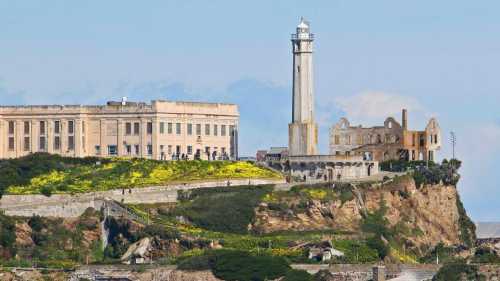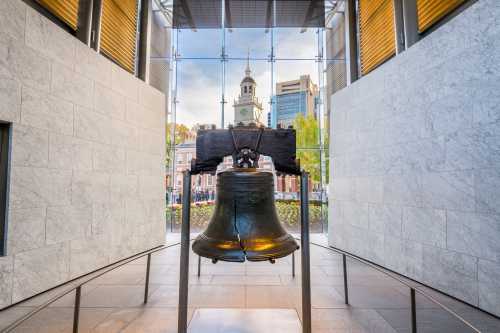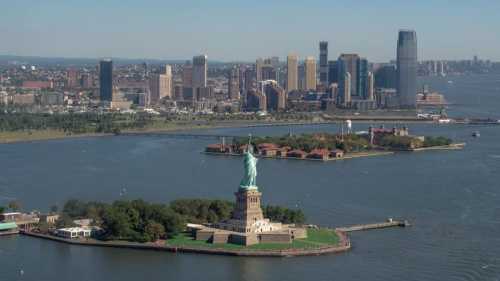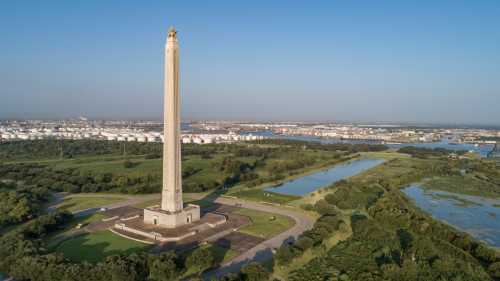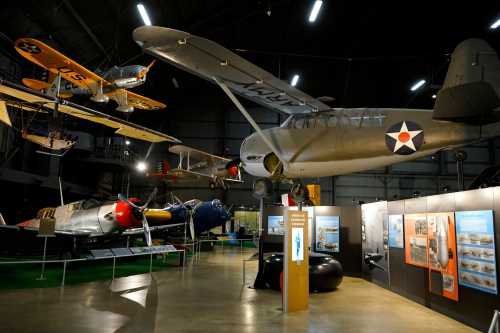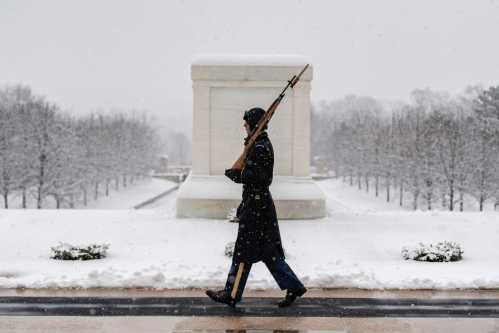Love history? Then you know it's not just about scouring collections of dusty old stories and relics but exploring the very foundation of who we are as people. Lucky for us, the best travel destinations across America for history buffs are hardly dusty. (OK a few are on purpose – and it's not the household-variety kind of dust.)
As it seems we are moving through time faster than ever, understanding history gives the clearest picture of what brought us to now. With that in mind, we’ve assembled a list of the absolute must-visit history destinations in the United States. These are the places where we can gain a deeper understanding of the past and our present to shape a brighter future.
Ready to time travel? Pack your bags (or, you know, just grab a snack) and let's go.
1. Bering Land Bridge National Preserve – Shishmaref, Alaska
We'll begin this list way back in time, with the migration of people from Asia into North America over 16,000 years ago. You can consider their resilience amid incredible, rugged landscapes with a visit to the North America Bering Land Bridge National Preserve, which spans 2.7 million acres. While its main mission is to protect significant plants, animals, and the history of this part of the world, the preserve hosts several events throughout the year. Every March, competitors in the famous Iditarod Sled Dog Race pass near the preserve, which hosts related events. The race goes all the way back to 1973 and runs between Anchorage and Nome, which is just to the south of the preserve. Paying a visit to this destination is a bit tricky since it's in a remote part of the state. Most folks start in Nome and hire a guide service to get them there. If you make it this far, you can't pass up the chance to visit Serpentine Hot Springs for a relaxing soak.
2. Saint Augustine, Florida
St. Augustine is a treasure trove of historical significance, with ancient sites and well-preserved architecture. Founded in 1565 by Spanish explorers, the city is the oldest continuously inhabited European settlement in the U.S. Nowadays, you can tour Castillo de San Marcos, a 17th-century fortress that was critical to defending the city against British attacks. The fort's impressive architecture, historical exhibits, and expansive coastline views are a must-see. Peer back into colonial times in the Colonial Quarter, a living history village with costumed interpreters and reenactments among period buildings. See demonstrations like blacksmithing and musket drills to get a glimpse into the lives of colonial St. Augustine residents. The Fountain of Youth Archaeological Park is also an essential stop to learn about both early Spanish and Native American history here. See artifacts, historical landmarks, and the legendary Fountain of Youth, believed to hold the secret to eternal youth and vitality. The park has many other attractions worth exploring, including a reconstructed Timucua village that offers insights into the lives of one of North Florida's indigenous populations.
3. Alcatraz Island – San Francisco, California
Most think of the long history of Alcatraz as a federal penitentiary, and yet touring it will teach you so much more. The island was first the site of a fort and then a prison for the U.S. Army from 1850-1933. In 1934, when the U.S. Bureau of Prisons took over the property as well as oversight of 32 previous hard-case prisoners left behind. The maximum security penitentiary operated until 1963 and became known as one of the most foreboding in the world. Over 1,500 people were incarcerated there before it closed. Alcatraz was at the center of controversy again in the mid and late-1960s, when American Indian activists laid claim to the island, occupying it for 19 months. and catalyzing changes in federal policy on behalf of the Red Power movement.
4. Mesa Verde National Park – Montezuma County, Colorado
Discover ancient history with a definite air of mystery at Mesa Verde National Park, where you can explore over 4,700 archaeological sites. You will see what remains of structures built and inhabited by Puebloan people from around A.D. 650 to 1300. Visit Cliff Palace, the largest cliff dwelling in North America, and learn about ancient farming techniques. One of the biggest questions surrounding Mesa Verde is why the Ancestral Puebloan people left the area after living there for centuries. There are many theories about what happened, including drought, climate change, or conflicts with other groups. With over 52,000 acres of canyons and mesas on the Colorado Plateau, Mesa Verde offers both natural beauty and historical significance.
5. Boston, Massachusetts
Founded in 1630 and one of the oldest cities in the United States, Boston was pivotal in the American Revolution and the birth of the nation. You'll need at least a few days to get the most out of just the historic sites here, including The Freedom Trail, a 2.5-mile trek through 16 historical sites including the Paul Revere House, Boston Common, and USS Constitution. Near one of The Freedom Trail sites, The Old South Meeting House, detour for the Boston Tea Party Ships & Museum. There, you can watch actors in period clothing interpret and reenact events of the Boston Tea Party on December 16, 1773. Other sites for history lovers include Fenway Park, which opened in 1912 and is the oldest Minor League Baseball stadium still in use, and the nation's oldest higher education institution, Harvard University, founded as "New College" not long after the city in 1636.
6. Williamsburg, Virginia
Step into the largest living history museum in the world in Williamsburg, Virginia, which will take you back to America's colonial era of the 18th century. Colonial Williamsburg covers 301 acres with period re-enactors strolling among dozens of restored and reconstructed history buildings. Must-sees include the Governor's Palace, the Capitol, and the Magazine. While you can walk the streets free of charge, a multi-site pass is the best value for checking out the 20-plus historic trade sites and tours of family homes, English gardens, government buildings, and art museums. Turn the page back further into time at the Jamestown Settlement, a living history museum that interprets the experiences of the colonists here in 1607, the first recorded Africans in Virginia in 1619, and the Native Americans who lived there before them all.
7. Philadelphia, Pennsylvania
Philadelphia is a city of firsts as the birthplace of the Declaration of Independence and the Constitution, making it a must-do for U.S. history lovers. Visit Independence Hall where these two venerable documents originated, then head to The National Constitution Center for a deeper exploration. See the home of Betsy Ross, our star-spangled seamstress who crafted the first American flag. Then head over to Liberty Bell Center to see the Liberty Bell, a symbol of American Independence for summoning Philadelphians on July 8, 1776, to hear the first public reading of the Declaration of Independence by Col. John Nixon. Continue to The Museum of the American Revolution, another destination dedicated to that period of time in American history. Just two hours west, fast forward almost 100 years to 1863 and The Battle of Gettysburg, widely considered the turning point of the American Civil War, stopping the Confederate advance into Union territory. Gettysburg, Pennsylvania is often recognized as one of the country's best small towns to visit for its historic sites and much more.
8. Natchez, Mississippi
Natchez is one of the oldest settlements on the Mississippi River and, because it didn't have a strategic position during the Civil War, much of its early architecture was spared. As a result, even a morning stroll in the town's old neighborhoods feels like you're in a different time altogether. Natchez is full of incredible antebellum homes and mansions, many of which are open for tours. The city also is the start of The Natchez Trace, a trail that's over 10,000 years old and was a critical trade route for Native Americans and early American settlers. The Natchez Trace is now a 444-mile driving route that extends from Natchez northward through Mississippi and into Tennessee. Historic downtown Natchez with its shops, dining, and architecture make it an excellent launch pad for taking in local history before setting out on the Trace.
9. Ellis Island – New York, New York
If you're an American citizen, there's about a 40% chance you can trace your ancestors through Ellis Island. From 1892 to 1954, more than 12 million immigrant steamship passengers arrived at Ellis Island, located at the mouth of the Hudson River in New York Harbor. As the nation's top federal immigration station, it processed the arrival of these immigrants before they struck out in pursuit of a new life in a new land. While the island was named a national monument in 1965 along with the Statue of Liberty, it wasn't until a restoration project in the late 1980s allowed the building to reopen as a museum in September 1990. While the museum's three floors are designed for self-tours at your leisure, you can watch a short film and take ranger-led tours over the first two floors if you like.
10. San Jacinto Battleground State Historic Site & Monument – LaPorte, Texas
This historic site near Houston, Texas is monumental in every sense of the word! The concrete-and-limestone octagonal San Jacinto monument is 567.31 feet tall, making it the tallest monumental column on the planet. Atop the Art Deco column sits a 220-ton star – the whole masterpiece honoring Texas having won its independence from Mexico. The monument and state historic site commemorate the Battle of San Jacinto, which occurred on April 21, 1836, and decided the Texas Revolution. Workers began constructing the monument 100 years after the battle, completing it in time for dedication on the anniversary three years later. When you visit the San Jacinto Battleground State Historic Site today, you can take an elevator up the monument for panoramic views, learn more about the battle at the San Jacinto Museum, and explore the battlefield and surrounding grounds of the 1,200-acre site.
11. Chimney Rock – Bayard, Nebraska
Put yourself in the shoes of westward-bound pioneers in the 19th century as you take in views of Chimney Rock. This natural landmark rises 350 feet over the North Platte River Valley, designating the end of the flat midwestern prairie and beginning of the Rocky Mountains. Stop in the visitor center for exhibits interpreting the history of the landmark and those who sought it to guide their way between the 1840s and 1860s. More migrants mentioned Chimney Rock than any other natural feature in their documentation of their arduous journey. If you're up for a hike, here's a trail that will take you closer to the soaring rock formation.
12. The Henry Ford – Dearborn, Michigan
While the name may suggest an automobile museum, you can expect that and far more at The Henry Ford. This world-class museum is one of the most unique and comprehensive in the world, especially for mechanical and technical innovation and its impact on culture throughout American history. The living history experience at Greenfield Village transports you through 300 years of bright ideas taking off and taking flight, starting with Thomas Edison's lab, rolling on to Model T rides, and landing at the Wright Brothers' bicycle shop. And those are just a few of the more than 80 historic buildings and experiences you will find. The many historic artifacts and vehicles at The Henry Ford include the presidential limousine of John F. Kennedy and the bus on which Rosa Parks made her stand for civil rights. Finally, peer into automotive innovation of the present and future with a tour of the Ford River Rouge Complex, where you will see modern assembly lines in action and learn about the history of automobile manufacturing.
13. National Museum of the USAF – Dayton, Ohio
The largest military aviation museum in the world, the National Museum of the United States Air Force has collected and preserved artifacts for just over a century. Today, aviation enthusiasts from all over the world travel to Dayton, Ohio to see over 360 aircraft and missiles on display here. Exhibits document the earliest days of flight through World War II, the Cold War, and space exploration. While it's extra special to visit for annual events honoring veterans or staging air shows, this museum at Wright-Patterson Air Force Base gets high praise from visitors any time of year. Some of the most famous aircraft at the museum include the Boeing B-17F Flying Fortress (Memphis Belle), “Air Force One” Boeing 707 U.S. Presidents Kennedy through Clinton, and a Titan IVB space rocket.
14. USS Arizona Memorial at Pearl Harbor – Honolulu, Hawaii
Many of the most powerful historic attractions memorialize tragic events that impart a somber feeling. That is the case with the USS Arizona Memorial at Pearl Harbor, where the emotional impact is appropriate to reveal insights into World War II — and the sacrifices made by the men and women who served during this pivotal moment in history. At this site, 1,177 crew members lost their lives on the USS Arizona during the attack on Pearl Harbor on December 7, 1941. Austrian-born architect Alfred Preis – who was sent to a U.S. internment camp following the attack – designed the white concrete structure that straddles the ship's sunken hull. At the visitor center, you'll see artifacts and exhibits for context about the attack and the history of the ship. Beyond this poignant memorial, Honolulu naturally is home to many other sites significant to its history that are definitely worth exploring, as well.
15. US Civil Rights Trail Sites – Montgomery, Alabama
Another powerful and moving experience can be found within the history told through the many Civil Rights Trail sites in Montgomery. Alabama's state capital is home to several of the sites, all offering insights into the struggles and triumphs of people fighting for justice and equality during the Civil Rights Movement. Must-visit stops include the Freedom Rides Museum, the Civil Rights Memorial Center, the Rosa Parks Museum, and The Legacy Museum. The latter explores the entire history of slavery, segregation, and mass incarceration in America. You'll also find several sites where you can explore the life and experiences of iconic civil rights leader Martin Luther King Jr., including Dexter Avenue King Memorial Baptist Church and the Dexter Parsonage Museum, which were the church where he served as pastor and the home in which he lived during his time in Montgomery.
16. Washington, D.C.
We're concluding this list with Washington, D.C. because when it comes to volume and value, it's hard to beat when it comes to the best travel destinations for history buffs in America. No doubt you can dig deeply into the history and heritage of the United States here, with some of the most significant landmarks and monuments in the country – the Washington Monument, the Lincoln Memorial, the White House, the Capitol Building, The National Archives, and Arlington National Cemetery, to name the most significant. Watching the changing of the guard at the Tomb of the Unknown Soldier at Arlington is a solemn, precision ceremony you will never forget. And then there are the museums, starting with the world-class Smithsonian Institution, a complex that includes the National Museum of American History, the National Air and Space Museum, the National Museum of African American History and Culture, the National Museum of Natural History, the National Museum of the American Indian ... and many more (no hyperbole here – the list is long!). If these aren't enough suggestions, D.C. has plenty of hidden gems, too.
You may have noticed this list of best travel destinations for history buffs across America includes some specific destinations and some entire cities. That's mostly intentional only for the sake of brevity and to emphasize some specific destinations. If you're a true history lover, you know it's waiting to be discovered at every turn, in every town. Within every destination, there are seemingly limitless stories – and then almost infinite nuggets of knowledge within each tale.
If you enjoyed this list, then you'll probably like starting your day with this interactive daily history mug from Uncommon Goods, which has a QR code that sends you to a historical event for every day of the year. How cool is that? It reads: "History: A record of the triumphant, terrible, and ceaselessly astounding stories throughout time." Sounds about right. Happy sipping and keeping your inquisitive mind engaged!
Subscribe to our newsletter
Get the latest updates and news
Thank you for subscribing!


